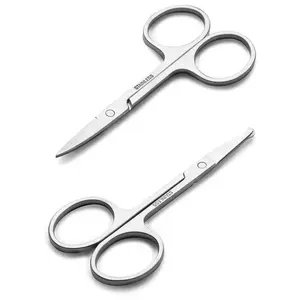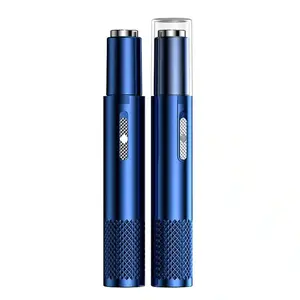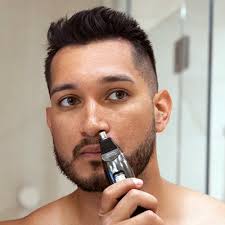How do you trim your nose hairs? Do you use a nose hair trimmer or do you just pluck the damn thing with your hands? This blog post explores six easy steps to trim nose hairs.
Nose hairs, also known as nasal hairs are thick hairs that grow inside the nose. They play an important role in protecting the respiratory system by filtering out dust, dirt, pollen, and other allergens before they can enter the lungs. However, too much nose hair can block the nasal passages and make breathing difficult. This is why it is important to trim nose hairs regularly.
Why is it important to trim nose hairs?
Some people naturally dislike the idea of pesky nose hairs but others primarily trim nose hairs for hygiene and comfort. There are a few reasons why it is important to trim nose hairs:
1. Hygiene: Nose hairs can trap dirt, dust, and other allergens, leading to congestion, sneezing, and other respiratory problems. Trimming nose hairs can help to reduce the amount of debris that gets trapped in your nose, making it easier to breathe and reducing your risk of infection.
2. Improves your Appearance: Long, visible nose hairs can be unsightly and embarrassing. Trimming nose hairs can help to improve your appearance and make you more confident.
3. Health: While nose hairs do serve an important function of filtering the air you breathe, too much nose hair can block your nasal passages and make it difficult to breathe. Trimming nose hairs can help to improve your airflow and make it easier to breathe, especially during exercise or when you are sick.
4. Reduces the risk of ingrown hairs: Ingrown nose hairs can be painful and infected. Trimming nose hairs can help to reduce the risk of ingrown hairs developing.
5. Improves breathing: Trimming nose hairs can help to improve airflow through the nose, making it easier to breathe. This is especially beneficial for people with allergies, asthma, or other respiratory conditions.
6. Reduces the risk of infection: Nose hairs can trap dirt, dust, and other allergens, which can lead to infection. Trimming nose hairs can help to reduce the amount of debris that gets trapped in the nose, making it less likely that an infection will develop.
What are the different methods for trimming nose hairs?
There are three main methods for trimming nose hairs:
1. Nose hair scissors: Nose hair scissors are small, sharp scissors with rounded blades that are specifically designed for trimming nose hairs. They are relatively inexpensive and easy to use. To use nose hair scissors, simply insert the blades into your nostril and trim the visible hairs. Be careful not to insert the scissors too far into your nostril, as this could injure the delicate tissue inside.

2. Electric nose hair trimmers: Electric nose hair trimmers are small, battery-powered devices with rotating blades that are designed to trim nose hairs. They are more expensive than nose hair scissors, but they are also easier to use and less likely to cause injury. To use an electric nose hair trimmer, simply insert the tip of the trimmer into your nostril and turn it on. The blades will rotate and trim the hairs that are in contact with them.

3. Waxing: Waxing is a more permanent method of trimming nose hairs. It involves applying hot wax to the inside of the nostril and removing it quickly, taking the hairs with it. Waxing can be effective, but it can also be painful and irritating. It is important to have waxing done by a professional to avoid injury.

The method you choose to trim your nose hairs is a matter of personal preference. Some people prefer the simplicity and low cost of nose hair scissors, while others prefer the ease of use and safety of an electric nose hair trimmer. For people who want a permanent solution, Waxing is a good option but it is important to be aware of the potential for pain and irritation.
Here are some additional tips for trimming nose hairs:
- Trim nose hairs after showering or bathing, when the hairs are soft and easier to trim.
- Be gentle and avoid forcing the trimmer into your nostril.
- Do not trim nose hairs too short, as this can irritate the lining of your nose.
- Clean the trimmer after each use to prevent the spread of bacteria.
How often should you trim your nose hairs?
The frequency with which you need to trim your nose hairs depends on how quickly they grow. For most people, trimming nose hairs once every two weeks is sufficient. However, if you have very fast-growing nose hairs, you may need to trim them more often.
6 Easy Steps To Trim Your Nose Hairs
1. Blow Your Nose: Before you start, make sure your nose hair is clean and dry. Blow your nose first and clean out any mucous or nose dirt that might get in your way.
2. Use a Quality Nose Trimmer: Invest in a quality nose trimmer designed for men. A quality nose trimmer is often super lightweight in the hand, very convenient to use, and also designed for precision.
3. Trim Diagonally: Insert the trimmer gently, trim slowly, and maintain a straight angle while trimming. You can also trim in circular motions for thick and excess hair. Some nose trimmers have built-in floating double-edged blades for a 360-degree capture of thick hair.
4. Mind the Hair: Ensure you maintain a low trim. Because you don’t want to completely remove all the hairs in your nose as they help in blocking particles and dust from your lungs.
5. Clean and Care: After you are satisfied with the results of your use, blow your nose a few times after trimming to get extra little hairs out. Don’t rinse your nose with water.
6. Maintain after Use: After you have achieved your perfect nose trim, ensure to clean and properly place your nose trimmer in its pack. For example, the Injina Nose Trimmer has removable washable cutter heads and lasting battery life (durable for 12+ hours) with a USB Charging Interface. Cleaning the nose hair trimmer after each use will help to prevent the spread of bacteria and germs.
Additional tips for trimming nose hairs:
- If you have sensitive skin, use a nose hair trimmer with a hypoallergenic blade.
- Avoid trimming nose hairs if you have a cold or flu, as this can irritate the lining of the nose and make it more susceptible to infection.
- Use a dedicated nose hair trimmer. These trimmers are designed to safely trim nose hairs without damaging the delicate skin inside your nose.
- Trim nose hairs after showering or bathing. This will help to soften the hairs and make them easier to trim.
- Be gentle. Do not force the trimmer into your nose, and be careful not to trim the hairs too short.
Trimming Nose Hairs is Easy
Trimming nose hair is an important aspect of personal hygiene and overall comfort. It is a simple and effective way to improve your appearance and health. By blowing your nose, using a quality nose trimmer, trimming diagonally, and following the tips above, you can safely and effectively trim your nose hairs without any risk of complications.


Leave a Reply